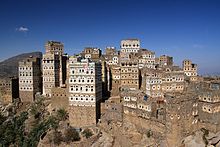al-Hajara
| al-Hajara | ||
|---|---|---|
|
|
||
| Coordinates | 15 ° 4 ' N , 43 ° 43' E | |
| Basic data | ||
| Country | Yemen | |
| Sanaa | ||
| ISO 3166-2 | YE-SN | |
| height | 2350 m | |
| Residents | 2000 (2000) | |
|
al-Hajjara lies like a fortress on the slope edge
|
||
Al- Hajjara (English Al Hajjarah ; Arabic الحجرة, DMG al-Ḥaǧara ) is a Yemeni city in Sanaa Governorate and the center of an administrative unit of the same name. The village was founded in the 11th century.
geography
The city is located 5 km west of the district capital Manācha . From Manacha, a track winds through the Haraz Mountains ( Jabal Haraz ) to the town of al- Hajjara at 2350 meters. The city is roughly translated as “die Steinerne”. Al-Hajjara is located on the western mountain slope, to the east adjoining the mountain Tihama . Al-Hajjara, like Manacha, gained importance due to its geographical exposure when the Ottomans had to keep the roads from Sanaa to the coast in check.
architecture
Al-Hajara's townscape is characterized by centuries-old stone tower houses , which are windowless at the bottom and in some cases are built up to six floors. The houses are crowded together. When viewed in conjunction with the steep rock, they give the impression of a closed locking bar. White borders around the windows should protect against the " evil eye ". Similar to Thula and Schibam Kaukaban , the city has long had cisterns and grain silos to withstand longer sieges. Thanks to this infrastructure, the inhabitants were able to withstand all attacks directed against them. Al-Hajjarah has at least twenty-three cisterns that were able to secure the water supply in times of siege.
As in many Yemeni cities, Jewish craftsmen used to live here . The access to the place is very narrow and can be locked with a heavy wooden door. Al-Hajjara is considered to be the figurehead of Yemeni mountain architecture . Nevertheless, its population is declining. A large number of houses are empty today, as Manacha is now considered a more convenient place to live. This contributed to the fact that the place was exposed to destruction in the 1960s , which resulted from air raids by Republican troops on the royalists entrenched in the place.
Surrounding area
The region around al-Hajjara is considered to be the most spectacular landscape in Yemen. Deeply cut valleys separate the steep mountain ranges and convey the image of extreme verticals. The small chambers and inaccessibility of the mountain world are characteristic of this natural area. There is often a lack of path systems. The western mountainous country thus formed a natural cultural boundary between mountain and lowlands, which offered protection against invading enemies. It is thanks to these circumstances that the tribal society in the highlands developed autochthonously over centuries.
In order to be able to wrest agricultural products from the scarce fertile soils, the population has always been dependent on terraced agriculture. Large parts of the surrounding mountain slopes are terraced. Mainly millet , the everyday drug qat and coffee are grown on them . For this purpose, species-rich dry forests have been cleared since ancient times . Succulent euphorbias (for example the Euphorbia ammak ) have established themselves as natural vegetation . Coffee can be grown where the valleys spread.
Wildlife
Various bird species can be found around the city, such as the Jemengirlitz ( Crithagra menachensis , a species of finch ), the South Arabian wheatear and the black- faced stone hen . The Yemen linnet and the Arabian woodpecker can also be found.
literature
- Hans Becker , Volker Höhfeld, Horst Kopp : Coffee from Arabia. the change in the meaning of a global economic good and its settlement-geographical consequence on the dry line of ecumenism . Wiesbaden (= Geographic Knowledge 46), 1979.
- Edmund Jacoby (Ed.): The visual world history of the Middle Ages . Gerstenberg, 2005, ISBN 978-3-8067-4594-8 .
- Aviva Klein-Franke: The Jews in Yemen . In: Werner Daum Yemen . Umschau-Verlag, Frankfurt / Main, ISBN 3-7016-2251-5 .
- Aviva Klein-Franke: Tradition and innovation in jewelry production in Yemen in the 20th century . In: Simurgh 1, pp. 19-29, 2005.
- Horst Kopp (Ed.): Geography of Yemen . Dr. Ludwig Reichert Verlag, Wiesbaden 2005, ISBN 3-89500-500-2 .
- Ester Muchawsky-Schnapper: The Yeminites: Two Thousand Years of Jewish Culture . Jerusalem 2000.
- Gerd Simper, Petra Brixel: Yemen. Reise-Know-How, Bielefeld 2002, ISBN 3-921497-09-4




